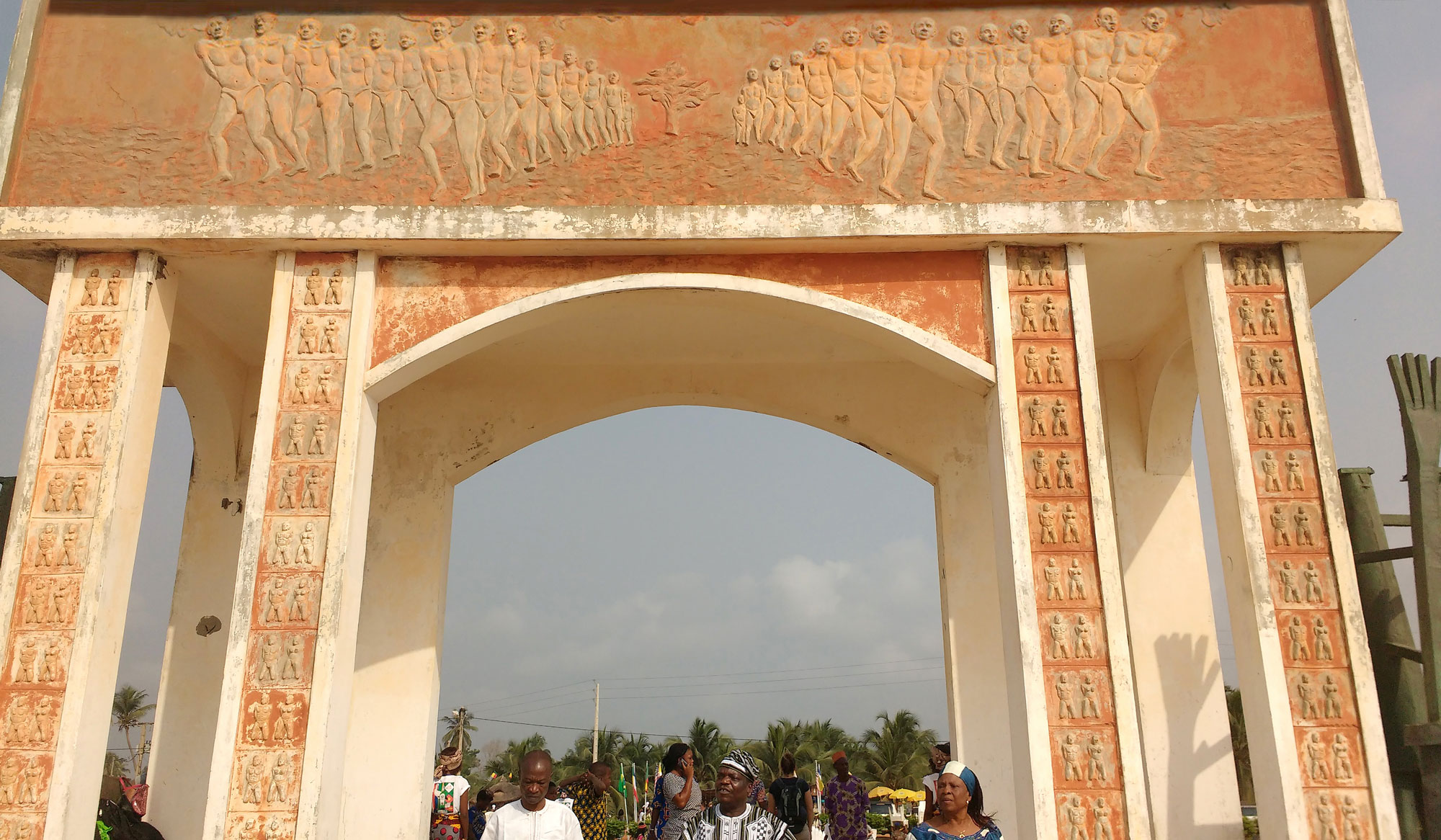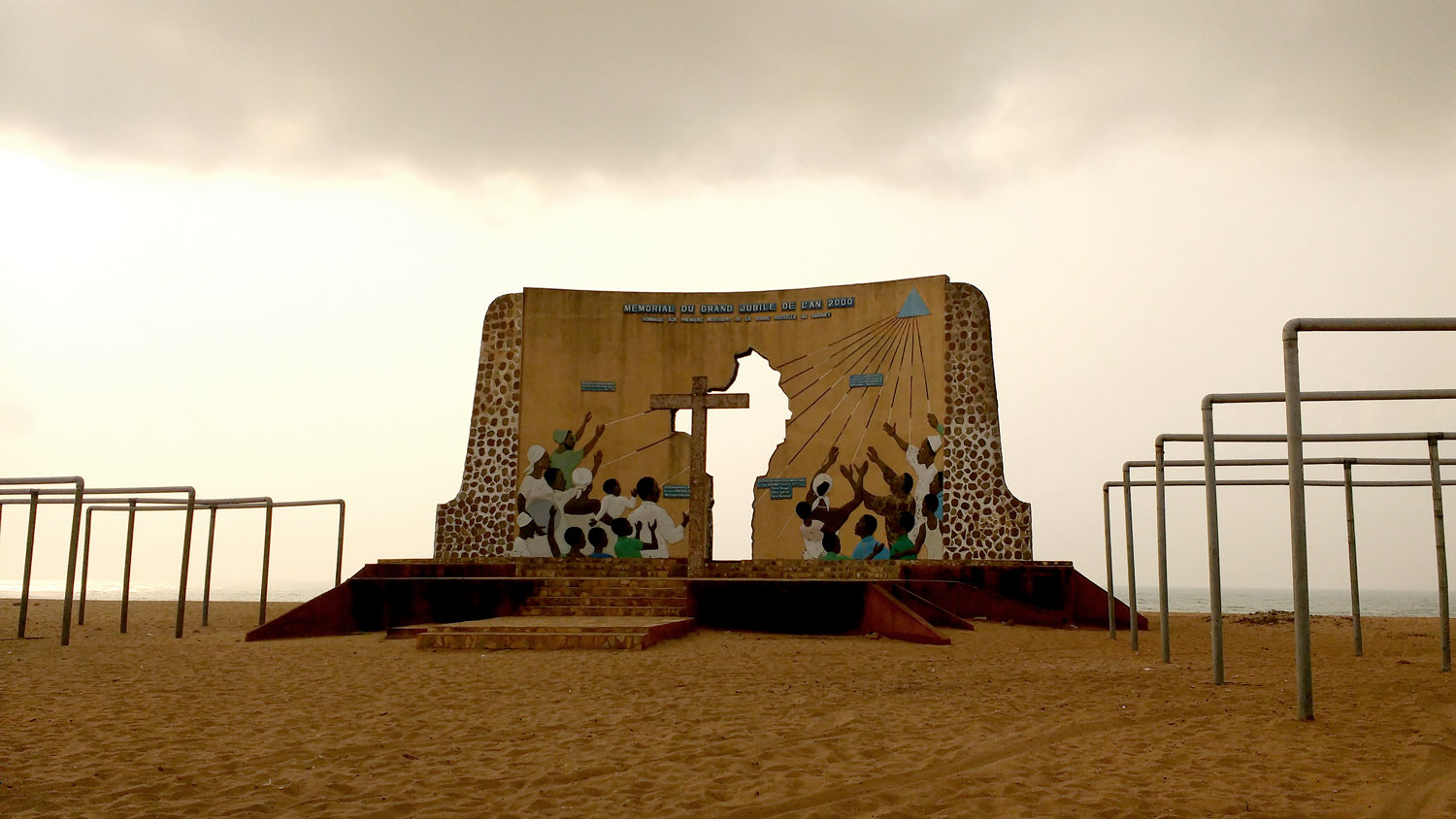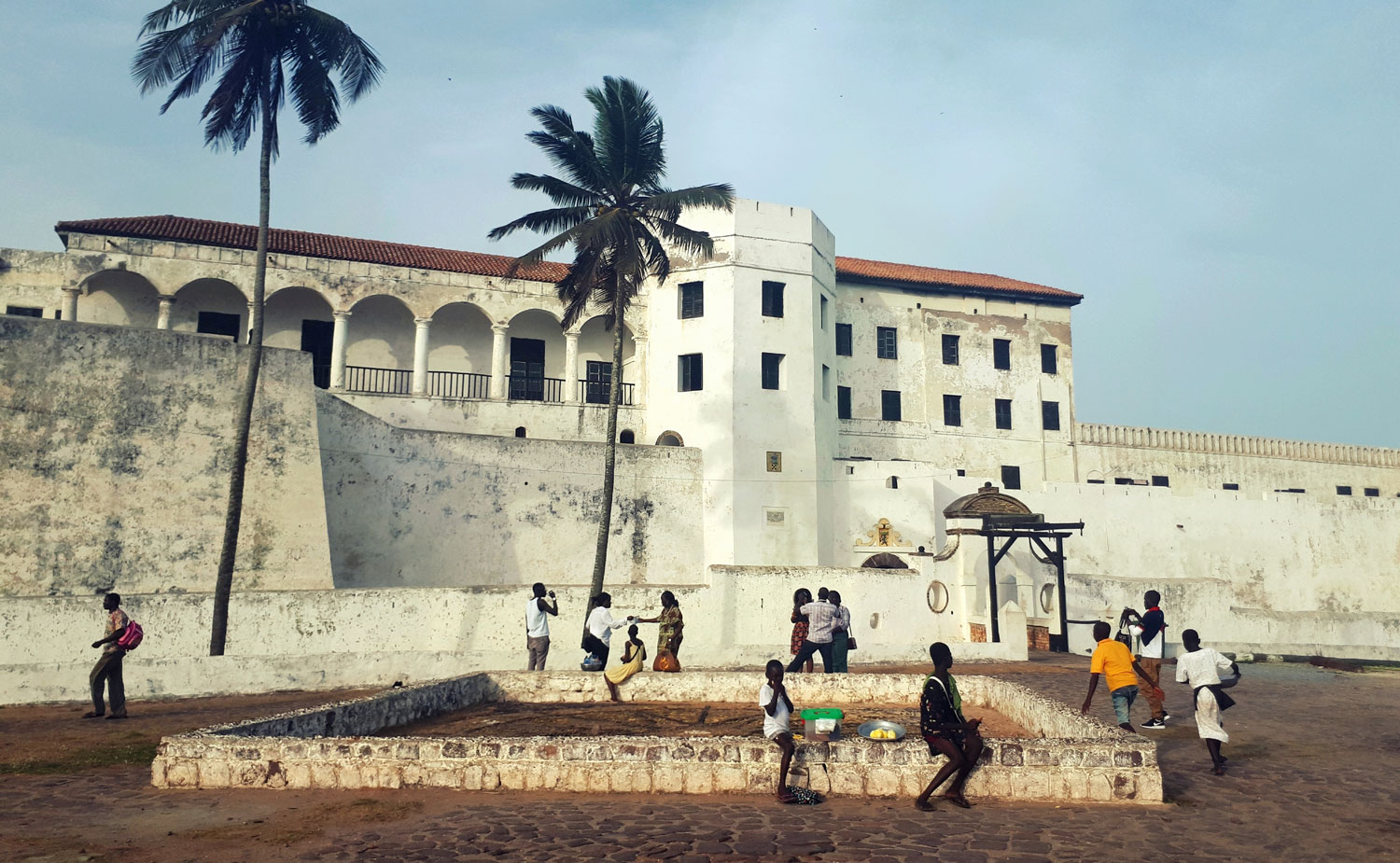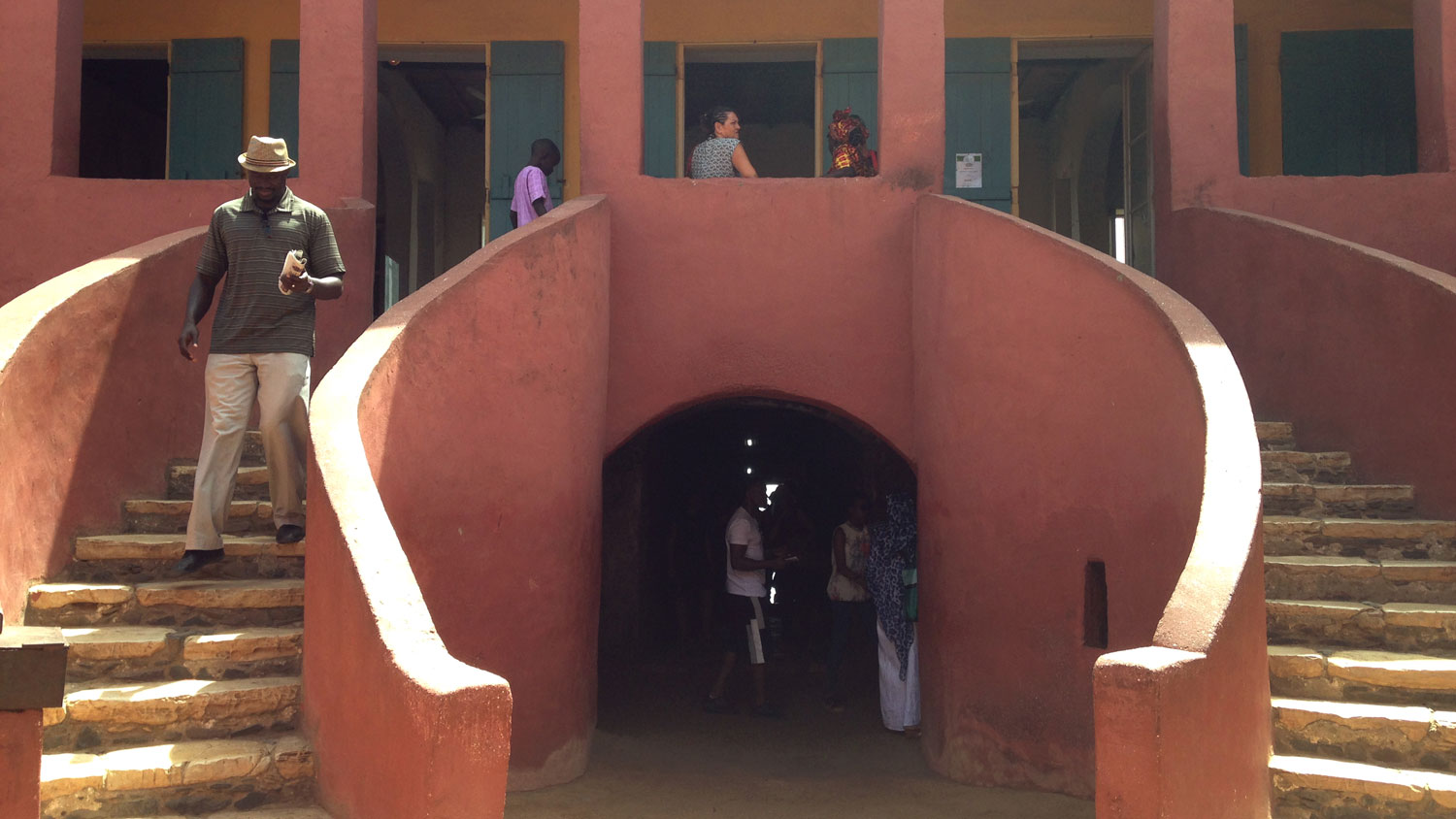
Plural, political, packaged: how West African monuments forced a reckoning with the past
In West Africa, mnemonic landscapes have been affected by various political and economic inputs, which in many cases have packaged history into a tourist attraction. The monument becomes the locus of a superimposition of local and global narratives. In this comparative field-research of historic and commemorative sites within the area, Sarah Gray focusses on the case of Benin’s sacred-scapes, exploring how this country might resist these potentially polarising processes, through an embrace of a functional pluralism that allows for the coexistence of heterogenous memories.
In 1988, UNESCO launched the World Decade for Cultural Development. The programme recognised and promoted the central role of culture within societal development, understanding it as the ‘the most important objective for the decade’.1 For Africa, the funding not only led to investments in heritage sites as lucrative assets, but it also raised concern over a ‘disappearing’ African past that needed to be articulated to current generations. This promotion and vending of historical legacies resulted in new monuments and celebrations which, over time, contributed to the reshaping of shared mnemonic landscapes.
Quick to lead regional trends, the small West African state of Benin inaugurated several commemorative sites in the mid-1990s, particularly within the coastal town of Ouidah. This article explores the functional pluralism of Benin’s sacred-scapes, by analysing their current uses and how they have been absorbed into contemporary politics. Drawing on comparative examples from Ghana and Senegal, it situates Beninese memorialisation within the larger tourism industry focused on remembering the Atlantic slave trade, and reflects upon the particular way in which this state articulates its commemoration of the past.
Benin’s sacred-scapes
Benin is the site of the former West African Kingdom of Dahomey. The Kingdom became a regional power from 1600 for two and a half centuries and was built on its central role in the trans-Atlantic slave trade. Coastal areas of Dahomey were controlled by the French in the second half of the nineteenth century. Today, the country has a democratic form of government steered by President Patrice Talon who ran on an independent ticket in 2016 after a successful career in business. The country’s national religion is Voodoo.
Tourism is one of the world’s largest foreign-exchange earners and, on the global tourist market, the history of the Atlantic slave trade is a lucrative product. In the 1990s, UNESCO funding transformed several West African slaving outposts from forgotten relics (or, in the case of Elmina castle in Ghana, services such as a post office) to international profit-making machines. The nationalist governments of the time quickly cottoned on and selling historical legacy became a staple economic policy.
Benin was quick to bid and receive funding for several commemoration projects: a Voodoo festival, first held 1993; a Slave Route commemorating the last walk on African soil for slaves bound for Brazil and the Caribbean, inaugurated in 1994; and (at the end of the Slave Route), a Door of No Return monument, completed in 1995. They are key features on Ouidah’s tourist circuit that also includes a restored Dutch fort and a mass grave for slaves who died before export. Each site comes with its own entrance fee, photo-taking fee, guide fee, toilet fee (where necessary), and almost obligatory souvenir purchase.
A frieze along the top frame of The Door of No Return depicts rows of slaves chained to each other and walking forward – out towards their deportation. The reference and meaning of the bas-relief is clear. However, there is no explanation of the monument’s historical, geographical or broader Slave Route context at the site.

The Door of No Return in Ouidah, Benin © Sergey Mayorov
Almost a decade later a Door of Return (or the ‘Memorial of the Great Jubilee 2000’) was inaugurated, part-funded by Catholic organisations. The monument, mirroring the dimensions and impact of its counterpart, the Door of No Return, has a cross at its centre and is painted with images of the faithful looking towards the door’s opening. It serves to welcome back ‘to the land of Dahomey the forgotten sons and daughters of the African diaspora’.2
Together, the Door of No Return and the Door of Return promote and reconstruct different memories of the slave trade and role of religion in present-day Benin. Yet, these representations of the past are ‘not necessarily from the point the view of those who were sent to the Americas as slaves, but from the point of view of … [UNESCO and] NGOs’.3
Today tourists, fishermen, local officials and religious representatives all gather at Ouidah’s beachfront commemorative sites. Religion plays a key role in this. Each year the town overflows with visitors to the annual Voodoo Festival, which opens with the Walk of Remembrance along the Slave Route and closes at the Door of No Return. Emphasising the sacred nature of the site, the Festival is renowned for its ability to pull spirit mediums who transfix onlookers with often violent and acrobatic possessions. Voodoo deities, known as fetishes, are represented across the town and Voodoo priests come from far and wide to celebrate ancestors and recognise the collective trauma in the country’s past.

The Door of Return in Ouidah, Benin
While centred on Ouidah, the Voodoo Festival is a nationwide event. Large celebrations are also held in Abomey, the heart of the pre-colonial Dahomian Kingdom. Those involved in festivities include slave descendants from Benin and the United States in addition to descendants of slave merchants. The Festival, and its commemoration of the past, is therefore inclusive of the experiences and memories of both enslaved Africans and African slave-traders. It is also illustrative of how in Benin, the Atlantic slave trade is understood as part of a wider historic experience that includes pre-colonial kingdoms and religious expression.
Beninese Voodoo is characterised by syncretism and tolerance. This enables it to prevail alongside Islam and Christianity. As explained by one Voodoo adept: ‘You visit the mosque on Friday, the church on Sunday and the Fetish any day.’ However, a small number of isolated attacks and kidnappings, allegedly from radical Catholic and Islamic groups, has threatened Benin’s religious heterogeneity. Unlike his predecessor Boni Yayi, who considered Voodoo to be a barrier to development, current President Talon has differentiated himself by publicly recognising Voodoo values, probably as a means of restoring peaceful religious pluralism. Talon’s strategy seems to understand the pertinence of people, places and artefacts in representing heritage. However, Talon insists he will serve only one term and therefore has a limited time to build a legacy. One of his first moves in this regard was successfully supporting popular requests for the restitution of Beninese artefacts, including statues of the kings of Abomey, looted by French raiders in the 19th century. Talon asserts that their return will help Benin’s developing tourism industry, and allow Beninese ‘to get to know better our cultural and historic assets’.4
Remembering the Atlantic slave trade through tourism: Ghana and Senegal
Five hundred kilometres east of Ouidah, Elmina Castle in Ghana was the first European fort to be built on the West African Coast. It served as a staging point for Portuguese, Dutch and British trade with the African hinterland and was used to store enslaved Africans before they were shipped to the Americas. In the 1990s, the Ghanaian government, under President Jerry Rawlings, introduced measures to boost tourism that led to renovation of Elmina Castle and its designation as a UNESCO World Heritage Monument.

Elmina Castle in Ghana © Thomas Gehmacher
Some African Diaspora communities condemned the renovation project, describing the cleaning and re-painting of the castle as ‘white-washing’ historical memories and erasing historical events.5 The fact that the function of the castle had changed over time, undoubtedly undergoing renovations to accommodate new uses (as prison and later a post office), was irrelevant to the voices of these critiques. However, since the African Diaspora make up a significant number of the Elmina Castle’s annual visitors, their critiques carry weight. Ensuring that the history presented there satisfies a Diasporan interpretation is therefore essential to the site’s management.
Tour guides at Elmina became compliant deliverables changing the tone and content of their tours depending on their audiences. For the African Diaspora, tour guides could deliver a historical narrative sympathetic to ‘the revival of the original purity, integrity, and authenticity of African culture, historically divided and corrupted by colonialism and the slave trade’.6 A tour for local Ghanaians, on the other hand, included few direct references to enslaved Africans, culturally a taboo subject, and many more references to the interactions of Ghanaians and Europeans, as well as to the role of the castle in imprisoning prominent Ghanaian figures.7 Ghanaians and African Diasporans experienced the Atlantic slave trade and its repercussions in different ways. For Ghanaians the castle represents an episode in a larger historical tradition whilst for the African Diaspora, it is often considered the starting point of their history. Elmina Castle must cater to tourists of all races and nationalities, whether they be on spiritual quests or merely casual observers.8
Further east, just off the coast of Senegal, Gorée Island is another UNESCO World Heritage site. The Island was an important outpost for the trading, sorting and shipment of slaves ruled in succession by the Portuguese, Dutch, English and French traders from the 15th to the 19th century. UNESCO describes Gorée as ‘memory island’ and ‘a pilgrimage destination for the African diaspora, a foyer for contact between the West and Africa, and a space for exchange and dialogue between cultures through the confrontation of ideals of reconciliation and forgiveness’.9 Gorée hosts the notorious House of Slaves. Now a museum, the eerie red-plastered building that edges the Atlantic Ocean was a holding place for ship bound slaves. In the several small damp cubicles on the lower floor men and women were chained, held for several weeks at a time, awaiting shipment. Moving in and out of these rooms, visitors can walk the final steps of African slaves on African soil. On the spacious and airy first floor, where merchants would meet, is a text-based exhibition of the slave trade funded by, among others, the UK government and Shell Oil.
At the height of UNESCO’s 1990s renewed interest in the region, anthropologist, Paula Ebron, published an account of her visit to Gorée as part of a ‘homeland tour’ sponsored by McDonald’s hamburger chain. For those making this personal journey, Ebron explains, Africa had to become a ‘liminal space’ emptied of national or local details.10 Thus, on arrival in Dakar, the tour group were uninterested in assessments of contemporary Senegalese politics. Even information about an imminent rally that would bring soldiers to the streets was met with the exasperated rhetorical response: ‘Why do we care about this? … What has this got to do with our homeland tour?’.11

House of Slaves on Gorée Island, Senegal
In contrast, at the House of Slaves the group were ‘solemn’ and ‘attentive’ as they soaked in their ‘collective history’ as described to them in ‘dramatic’ form by the Museum’s curator.12 Moving through the sacred-scape, created at Gorée, Ebron explains, ‘transported [us] back through time; through our ancestral connection … The tour and the rendering of the slave experience into a narrative conspired along with the heat of the day, the small windowless rooms, and the chains on the walls to convey a sense of … a filling-in memory’.13
The actual role that Gorée played in the slave trade is fiercely contested among historians and evidence suggests that it may well have been minor. However, this site (like Elmina Castle) has become symbolically significant for African Americans as well as financially significant for tour operators.14
Contestation over the presentation of the past is particularly vibrant, where it concerns the Atlantic slave trade and the colonial encounters growing from it. Not surprisingly, related commemorative sites are increasingly open to challenge. Since 2015, furore over the Cecil Rhodes statues in Oxford and Cape Town is a case in point. Even before this, the French Palace of the Porte Dorée, which in 1931 was dedicated to the history of colonialism, symbolically reopened in 2012 as a completely new project: The Museum of the History of Immigration.15 The recent launching of investigations into the past, including Cambridge University’s enquiry into how the institution benefitted from the Atlantic slave trade, is another highly politicised arena. These reinterpretations of history can often be accompanied by litigation alongside demands for apologies and reparations.
Salience and contemporary politics
The commodification of history is a growing industry. As a major source of international revenue, it has the ability to shape economic and development policies. It also shapes identities and memories. For many people museums, ‘sacred-scapes,’ and commemorative festivals are the first or only point of interaction with history. The presentation of information through, what are often guidebooks’ ‘Top picks’, is therefore instrumental in shaping individual and collective impressions of culture and history. These impressions can in turn shape policy.
There are numerous examples from around the world of how history has been presented in a format that legitimises political strategies. Or where historic events are omitted or strategically forgotten in order to justify political agendas. At Elmina Castle and Gorée Island, fashioning commemoration to suit Diasporan tastes can encourage an African American remembrance of the Atlantic slave trade in a way that often conflicts with local understandings.16 This interpretation strengthens their demands for reparations and international apologies. UNESCO claims that even the Beninese Slave Route which is less popular with African American tourists, ‘played a significant role in securing recognition by the United Nations, at the [2001] World Conference Against Racism, Racial Discrimination, Xenophobia and Related Intolerance, … of the slave trade and slavery as crimes against humanity’.17 The conference was symbolic of an official recognition of commemoration and remembrance; the official recognition of a commodified and packaged history. Shortly after, the French Parliament recognised that the slave trade was a crime against humanity while the German Foreign Minister recognised ‘the necessity for Germany to accept guilt and responsibility for its participation in colonialism.’18
More recently, centenary celebrations, often taking place at heritage sites with a monument becoming a physical and metaphorical frame, have also played a central role in raising awareness and contestation of conventional slave trading and colonial memories.19 A surge in public interest in the Herero genocide in Namibia and the Jallianwala massacre in India on their centenaries in 2004 and 2019 forced a reevaluation of the past and consideration of apologies in Berlin and London respectively. Thus outflowed a series of colonial apologies ‘in which European elites simultaneously wrestle[d] with the incongruities, contradictions, continuities and ruptures of the imperial past and the liberal present’.20 In 2007 for example, at a commemorative ceremony at Elmina castle, then Prime Minister of Britain Tony Blair apologised for British role in the slave trade.20 Ten years later, after having visited the Algerian national monument to countries ‘Million Martyrs’ then French Presidential candidate Emmanuel Macron stated that France’s 132-year colonisation of Algeria involved ‘crimes and acts of barbarism’ that would today be acknowledged as ‘crimes against humanity’.22
In his 2017 monograph, Empires of Remorse, Tom Bentley demonstrates how apologies for historic injustices are a recurring and consistent issue that since the 1990s (the height of UNESCO’s African interventions) have become a normative part of diplomatic relations rather than a phase that can be expected to expire. The case studies of Germany-Namibia (Herero massacre), Belgium-DRC (assassination of Lumumba), Britain-Northern Ireland (Bloody Sunday) and Italy-Libya (colonial wrongs) illustrate just how widespread and common these African and European reinterpretations of the past are.

A spirit medium at the Voodoo festival in Ouidah, Benin
Packaging History
Heritage sites create powerful mnemonic landscapes that can be used (and abused) for political means. They serve as the backdrop to collective memory creation or celebration. They also serve as a stage for political overtures by those seeking support at home, as in the case of Macron is his attempts to gain the French-Algerian vote, or partners abroad, as in the case of Tony Blair who sought to establish new Africa-UK trading relationships.
The examples from the tourism industry of Benin, Ghana and Senegal illustrate that history and memory are interactive. They rely on a mediator; a policy, a symbolic artefact, an event or a guide and an audience; an individual or a group. The audience personally reconfigures what the mediator informs them to create a contemporary memory.
History and memory are publicly popularised and projected by tourism. These processes are often the result of influential international organisations, non-governmental organisations or government policy. The Atlantic slave trade itself impacted different areas of West Africa in very different ways at different times with different repercussions, which may explain how differences in memorialisation have arisen. However, as memory is created in the present not the past, the main drivers behind remembrance and commemoration are contemporary factors such as economic development and global markets. This explains why the repackaging of history – monuments focussing on the enslavement of Africans are often aimed at foreign audiences.
In Benin, where the African American Diasporan market is comparatively small, UNESCO funding was used to create heritage sites with plural functions. Beninese remembrance of the Atlantic slave trade is infused with cultural collaboration between and within religions, stimulates engagement from political actors and gives significant emphasis to the reciprocal international flows that Voodoo represents. This plurality allows for the co-existence of several different interests and memories – a hard to feat to master in a climate of increased contestation of the past.
Footnotes & references
[1] Kankpeyeng, Benjamin W. and DeCorse, Christopher R. (June 2004) “Ghana’s Vanishing Past: Development, Antiquities, and the Destruction of the Archaeological Record”. African Archaeological Review. 21(2), pp.89-128
[2] Akhtar, Saima/Colmenares, David H. (August 2016). “The Slaving Port of Ouidah and Monumental Discourse around the Atlantic Perimeter.” From Traditional to Contemporary Aesthetic Practices in West Africa, Benin and Togo. The Art Histories and Aesthetic Practices Blog. Ed. Baader, Hannah
[3] Araujo, A. L. (2010), Public Memory of Slavery. Amherst, NY: Cambria Press
[4] Buffenstein, Alyssa. (2017). Benin Urges France to Return Precious Objects Taken During Colonial Era. Available: https://news.artnet.com/art-world/benin-stolen-objects-repatriation-france-904217. Last accessed 15th Sep 2019
[5] Bruner, E.M. (1996). “Tourism in Ghana: the representation of slavery and the return of the black Diaspora”. American Anthropologist. 98(2), p.294
[6] Hasty, J. (2002). “Rites of Passage, Routes of Redemption: Emancipation Tourism and the Wealth of Culture”. Africa Today. 49 (3), p.52
[7] Ibid. p.193
[8] Timothy D. et al. (eds.). (2006). Tourism, Religion and Spiritual Journeys. London & New York NY: Routledge.
[9] Unesco. Island of Gorée. Available: https://whc.unesco.org/en/list/26/. Last accessed 15th Sep 2019.
[10] Ebron, P. (1999). “Tourists as Pilgrims: Commercial Fashioning of Transatlantic Politics”. American Ethnologist 26(4), p.912
[11] Ibid. p.919
[12] Ibid. p.922
[13] Ibid. p.923
[14] Ibid. p.920
[15] Gildea, R. (2019). Empires of the Mind. Cambridge: Cambridge University Press
[16] See: Richards S. (2005). “What Is to Be Remembered?: Tourism to Ghana’s Slave Castle-Dungeons’’ Theatre Journal. 57(4)
[17] Unesco. (2019). Celebration of the 25th anniversary of the Slave Route Project in Benin. Available: https://en.unesco.org/events/celebration-25th-anniversary-slave-route-project-benin. Last accessed 15th Sep 2019
[18] Bentley, Tom (2016) citing Schäfer-Wünsche. Empires of Remorse: Narrative, postcolonialism and apologies for colonial atrocity. London & New York NY: Routledge. p.86
[19] Ibid. p.90
[20] Ibid. p.3
[21] BBC. (2007). Slave trade shameful, Blair says. Available: https://news.bbc.co.uk/2/hi/uk_news/6493507.stm. Last accessed 15th Sep 2019
[22] Financial Times. (2017). Macron calls France’s colonial past a ‘crime against humanity’. Available: https://www.ft.com/content/87d6f430-f521-11e6-95ee-f14e55513608. Last accessed 15th Sep 2019
Images courtesy of Sarah Gray unless otherwise indicated
Recent articles

Southern California is many things. Quite infamously, it is known as a landscape defined by the automobile, from the emergence and diffusion of the highway system to fast food burgers, and the suburbanization of the United States. Walking this place then, would seem not only inconvenient, but ill advised. In… Read more »

What is today known as ‘whistleblowing’ could once take the form of interacting with a threatening gaze carved into the city wall. It is the case of the ‘boche de Leon’ or ‘lion’s mouths’ disseminated by the old Venetian Republic throughout its territory to suppress illegal activities. Through a close… Read more »

As he navigates through the recurrent lockdowns of the pandemic, stranded between hitchiking and muggings, job hunting and separations, Fabio Valerio Tibollo rediscovers photography as a powerful coping mechanism. Recording everything that happened around him for one year straight, from attending momentous events to finding curiosity in shots of simple living,… Read more »

